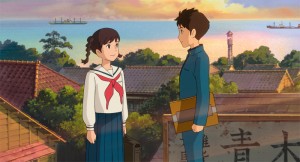http://www.youtube.com/watch?v=EiatBUo6crs
It’s 1962 when recently widowed Beth and her son Arthur move to rural Granite Flats, Colorado. They meet a town thrown into fear and suspicion after a terrible explosion at the nearby air base. As the military and police investigate, Arthur and his new friends explore the mystery and begin to unravel a web of secrets that will change Granite Flats forever.
Granite Flats is a new series on BYUtv, premiering Sunday at 7 and available On Demand, on iTunes, and pretty much every place. It is that rarest of shows in this era of micro-targeting, a genuinely family-friendly story that can be enjoyed by all ages and discussed afterward. Producer/director Scott Swofford talked to me about what they wanted to accomplish, where the idea came from, and the surprising reason it is set in the 1960’s.
Your background is in documentary, isn’t it?
Yes, but in the IMAX world you’re called upon all the time to do re-creations, and that is more like drama than documentary. And this project is kind of a pioneering thing. We’re trying to do family entertainment that isn’t kiddie shows. The ususal skills set didn’t apply because this was new for everyone.
How did it get started?
We had this channel with university support that was primarily used for forums and speeches but could be much more. You’re on in 60 million homes; what could your voice for good be in the world? Viewers wanted entertainment. Don’t you want to be educated, edified, and enlightened? The answer we got was, “Entertain us and sneak in what ever you want.” It’s like, kids want to eat pizza but we want them to eat broccoli. If there’s too much broccoli, they won’t eat it. Reality is popular now, but scripted stories transport us to someplace, we get invested in characters, and it’s more emotional, not just intellectual.
Was it a challenge for BYUtv to produce a scripted show?
This market has done scripted before, like “Touched by an Angel.” The execution phase has been easy for us but we hadn’t generated original programming. It’s an opportunity for us because hardly anyone is in this category of programming that is truly for the whole family and not just something that is inoffensive enough so kids can watch. We were committed to a story that was appealing to kids but also had a sophisticated plot line to make it interesting. We decided to set it in the 60’s. By putting our desire to communicate in a time machine it makes it easier to be compelling, other side of the county than mad men. And it was routine in a 60’s story that you would not have some of the bad language and family-unfriendly themes of shows set in our time.
It began with a 20 minute concept piece called “Heaven Under the Table” about a kid who lost his dad and struggled with the idea of where he went. He saw a satellite and thought maybe it was his dad. We dropped into it all the shenanigans the government was doing in the Cold War.
Tell me about the people who are working on “Granite Flats.”
We have a highly diverse group of writers including a Mormon, an Orthodox Jew, A Buddhist, an agnostic — which helps us explore issues of faith, struggles, making choices, and ethical dilemmas. And many of the actors we went to were very experienced and very expensive. But they said “I don’t get to do anything like this.” They loved the script, so they signed a not for profit SAG contract. Our budget is about a third of what Hollywood spends on a drama. We are lucky to have a lot of vets who have done this before.
What were some of the challenges of having the story set in another time period? Was there a lot of research involved?
Some details I pull right from my memory, the pencil sharpeners and the classrooms. But sidewalks? Air conditioners? Power poles? We have to Google everything. The costume designer got a lot of old LIFE magazines. Fortunately, there’s a retro surge in clothing so that wasn’t hard to find but the vehicles were a challenge. We filmed in a mining town called Magna, Utah. They were great — they let us redo signage and recreate storefronts, ferreting out the nuggets of that era.
The younger actors had some surprises. We shot a scene with a 30-year-old actress. She was shocked by the coin pay phone and jumped when it dinged. Kids in the cast ask, “what does this mean?” about the idiomatic expressions. But their parents say we’ve improved their language!
What makes you think this will appeal to all ages?
If they sit down and watch together, which is the goal, the parents will want to ask, “Did we we really do that to ourselves in the Cold War” and kids will say, “How is that chracter going to deal with the bully?” And I showed my grandchildren and my 96-year-old father the first two episodes and they both said, “Why did you bring only two? What happens next?”

